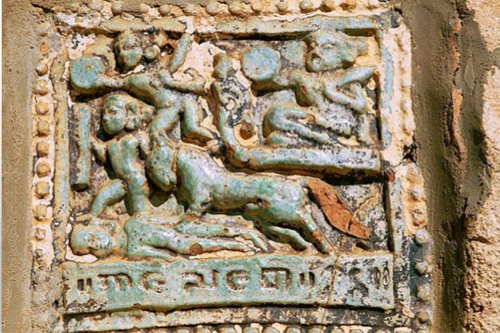Whenever you decide to travel to a new country, the culture, tradition, and rich history are perhaps the most interesting allure for you to discover. Bagan, with thousands of years of development, has been ruled by several dynasties. In this article, we will bring you specific information about Bagan dynasties for you to have great knowledge about Bagan before picking up a Bagan tour package to discover this wonderful landscape.
Myanmar chronicles state that Bagan was founded by Thamoddarit in the early 2nd century as a small kingdom. A few years after the Pyu kingdom of Srikhetera was destroyed by the Nan Ch'oa in the late 9th century AD, Pinbya, who was the 34th ruler of Bagan, united the nineteen villages including Bamar and Pyu settlements, into one unified kingdom. The dynasty was to last through 55 rulers. It was only with the ascension of Anawrahta, 42nd in the dynasty that a definite record began.
Anawrahta (r. 1044-1077) 33 years
Anawrahta's true name was Aniruddha, which he inscribed on clay votive tablets donated at various pagodas and at all corners of his kingdom. Aniruddha means 'unstoppable, ungovernable and self- willed': a truly prophetic name.
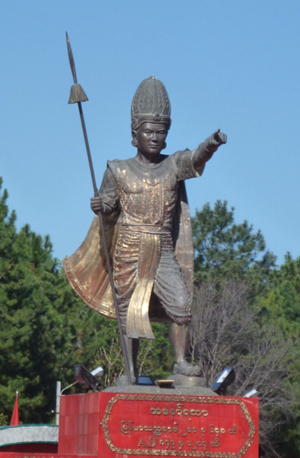
When Nyaung Oo Saw Rahan, 38th in the dynasty, passed away Anawrahta's father Kun Saw ascended the throne. According to the protocol, he took over the three queens as well. The two senior queens were already pregnant by the former ruler and gave birth to princes Kyiso and Sokkate respectively, while the youngest Anawrahta was born to Kun Saw. When Kyiso and Sokkate grew up they forced Kun Saw to abdicate and become a monk and Kyiso took the crown. After Kyiso's death, Sokkate took the throne as well as Anawrahta's mother. Anawrahta who by then had grown up killed Sokkate in single combat. He urged his father the monk to retake the crown but was told to rule instead. Anawrahta expanded his military might and he was the first to use trained elephants in his army.
It was during his reign that the First Myanmar Empire was forged and Bagan became known as Arimaddana Pura, "Crusher of Enemies". He and his four ablest generals subdued the Nan Ch'oa, whose armies had attacked the Pyu. He ensured that lesser kingdoms surrounding his country paid him tribute and he set up a line of forts along the borders to ensure their submission. His greatest work was strengthening Theravada Buddhism with the advice of his revered abbot Shin Arahan.
He left dozens of clay votive tablets in various old and new pagodas all over the country, signed by with his hand 'Aniruddha'. Many were found in the relic chamber of the Baw Baw Gyi Pagoda of Srikhetera after he presumably removed the relics to Bagan. Others votive tablets signed by him have been found in a pagoda he built n°t far from present-day Yangon. Votive molds made of bronze, stone, and terracotta have been excavated and it seemed that the king id cast the tablets 'with his own hands' as he so often inscribed.
Folklore says that Anawrahta, 'this noble king, full of glory, might of and dominion' was killed at the age of 75 by a rampaging wild u ° possessed by an evil spirit.
Sawlu (r. 1077-1084)
Anawrahta's son Sawlu succeeded him. His childhood friend Ramar Khan, son of his tutor, took advantage of Sawlu's weakness to imprison him and take the throne. When Kyansittha heard of it he returned from exile to save him, but thinking that Kyansittha came to kill him, Sawlu cried out for his guards for help. Saying to him, "Stay here and die like a dog," Kyansittha left him. Raman Khan fearing more rescue attempts had his prisoner killed. Sawlu's royal title was Sri Bajrabharana, 'Fortunate Bearer of Thunderbolts': it seemed he was neither fortunate nor had the caliber to bear any thunderbolts, a symbol of military strength. He died at the age of 46
During his reign of seven years, the Pahtothamya Temple was built, the earliest to be beautifully decorated with wall paintings. Few scholars would credit it to Sawlu as he 'had the power neither to devise a thing nor to perform it.'
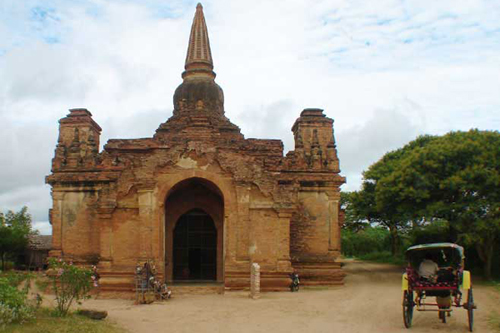
Kyansittha (r. 1084-1112)
He was also known as Lord of Hti Hlaing or Hti Hlaing Shin, or as written in Old Bamar, 'Dhiluin Shyan'.
After Sawlu's death, Kyansittha returned to vanquish the usurper Raman Khan. He asked the ministers to have someone of royal blood take the crown but they voted Kyansittha to be king. His origins were obscure and in his inscriptions, he often stated that his father was the Sun and his mother, a maiden born inside a Bael fruit.
Another vague reference was thought to mean that his mother was a Rakhine princess from the Candra Dynasty of Vesali, contemporary to the Pyu civilization but a race that exists to this day. His royal title was Sri Tri Bhuvanadit Dhamma Raja, 'Fortunate Son of the Three Worlds, King who dwells in the Teachings of Buddha'.
He promoted diplomacy with other states and especially had good relationships with the Mon race of the South, often using their language and even appointing Mon officials to court. Perhaps it was good diplomacy or perhaps it was the love for his Mon queen Mani Sandar, Crown of the Moon, who was once a consort of Anawrahta and on whose behalf he had been exiled.
His chief queen was Abeyadana, Beloved Treasure, of Mahayana Buddhist faith. Another queen was Thambula, Moon of the Three Worlds, a country girl he met while in exile. Folklore says that she came to him years after he became king, bringing their son Raja Kurma. By then Kyansittha had made his grandson the heir but Raja Kurma was content in his fate. Some scholars believe that this son stepped aside to support the alliance between his father and the Mon kingdom since the grandson was of the Thaton king Manuha's lineage.
Although he did not become king, Prince Raja Kumar played an essential role in Myanmar's history. The stone inscription in four languages of Pali, Pyu, Mon, and Bamar he set up as a dedication of Myinkaba Gubyauk Gyi Temple to his father enabled scholars to decipher the lost language of Pyu. This pillar is also called the Mya Zedi Stone as it was found in the compound of Mya Zedi Pagoda standing next to the Gubyauk Gyi Temple where it was originally enshrined.
Although Kyansittha was not of royal blood in a time when ancestr} counted most, he was proclaimed to be 'no common man, but one great and glorious' and so he proved to be. He died at the age of 80, a well-loved and great king.
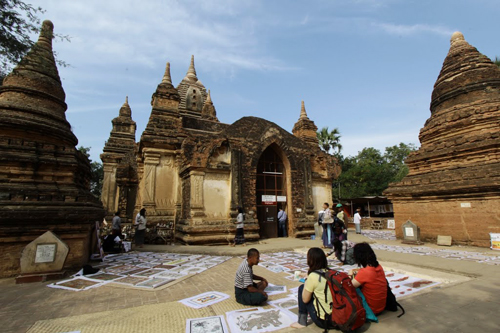
Alaung Sithu (r. 1112-1166)
He was the son of Kyansittha's daughter Shwe Einthi, born of Abeyadana. She was in love with a prince of another country but was forced to marry a Mon prince, the descendant of King Manuha (Makuta) who was captured from Thaton. Princesses of the time were often pawns in political games.
His royal title was Sri Tri Bhuvanaditya Pavara Dhamma Raja, 'Sun of Three Worlds, Most Excellent King of the Law of Buddha'.
It is said that he was a great king and “very beautiful to look upon; his voice was melodious. The song he loved and the sound of harp and horn”.
His long reign was one of peace and prosperity. His greatest temple was Thatbyinnyu, a magnificent, three-storied edifice soaring to the les, the biggest and the most majestic in Bagan. His other merit was the Shwegu Gyi Temple that he built near his palace. It was inside this elegant little temple that at the age of 101, he was suffocated ° death by his son Narathu.
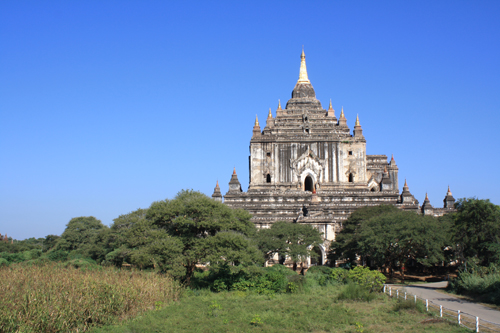
Narathu (r. 1166-1170)
A cruel and murderous king, all his life he “raged furiously with wrath and pride. He ground down and oppressed the folk and the villagers”.
Narathu was the son of a handmaiden of his father, “in rank less than a queen and more than a concubine”.
Narathu began the construction of the Dhammayan Gyi, a hulking, massive temple. The masonry work is so fine that there is hardb' space for a needle tip to be inserted between the bricks. It is said that if he could insert a needle, he would have the mason's hands cut off.
One of his queens was an Indian princess, the youngest consort of his father. He killed her for scorning him whereupon, it is said, her father sent eight Indian soldiers to assassinate him. He died at the age of 49 and went down in history as the 'Kala-kya Min', a King Felled by Indians. The Dhammayan Gyi was left incomplete.
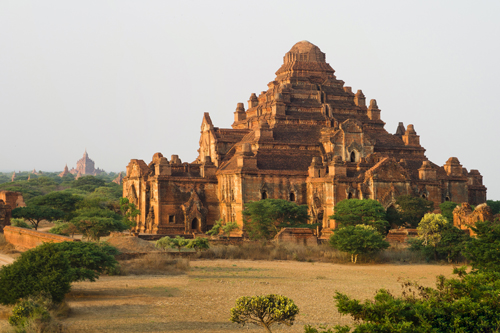
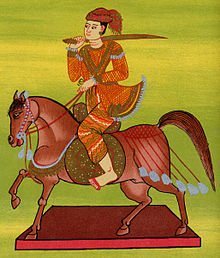
Minyin Naratheinkha (r. 1170-1173)
“In his reign, there was an abundance of rain and water, and the country was fat, pleasant and fertile”.
Narathu's son Minyin Naratheinkha succeeded to the throne. His reign was as short as his father's, for although he already had three queens he cast lustful eyes on his brother's wife. It is said that she. was named Wailuwaddi or Maiden Born of a Bamboo, “a little daughter born of heat and moisture, having great beauty”. She was first presented to him but he thought her earlobes too long and discarded her to his younger brother, the crown prince Narapati Sithu.
The queen mother took the young lady in hand and trimmed her earlobes, whereupon she turned into a great beauty. The crown prince was extremely happy with her but when the king his new sister-in-law, instantly regretted that he had cast her aside. On a pretext, he sent his brother to the border to fight non-existent invaders and took her forcibly to his bed. The brother, suspecting as much, rode back after getting the news from a spy he had left at the palace. He killed his brother to take the throne and take back his wife. Minyin Naratheinkha died at the age of 35.
Narapati Sithu (r. 1173-1210)
He too took a brother-in-law's wife as the queen but was wise enough not to steal her outright but to exchange her for two young handmaidens.
His temple the Gawtawpalin means a 'Throne of paying homage' and believed built as an act of penance when he went blind after declaring himself greater than his ancestors, an act of high disrespect.
Narapati Sithu ruled for 37 years, and by then the use of Bamar language became more popular. The first lines of inscriptions were mostly a prayer in Pali or Old Mon but the text became Bamar. The writing style was simple yet elegant. Seven hundred years later, in the early 1900s, young writers who were fed up with the fanciful and poetic literary style of the time reverted to using this simple straightforward prose. Their 'inventive style' called Khit San Sarpa, or 'dawning of new literature', has lasted to modern days with few changes.
He fell ill and dying at the age of 74, after he had 'advanced the welfare of the great religion, his own welfare, and that of the generations of sons grandsons, and great-grandsons after him, for full seventy-four years of his life and he failed not in the ten duties of a king'.
Nadaung Mya a.k.a Htilominlo (r. 1210-1235)
His name was Zeya Theinkha and his titles were Nadaung Myar meaning He of the Many Earrings and Htilominlo, meaning Chosen by King and Guardian Spirit of the Royal Umbrella. His father before he passed had named him heir, he who was the youngest of five sons. The Spirit of the White Umbrella, the symbol of royalty, has also shown its preference by bending towards him.
Nadaung Mya was by all accounts well-loved by his older brothers, and they had not raised objections to be passed over; rare in the times when brother killed brother for power.
Since he was a child, he “would ever show honor and reverence to his four brothers. Every holy day he would visit their houses and failed not °nce to pay his duty”.
He was ‘peaceful and deliberate, master of the ten kingly duties”. He died at the age of 60.
Kya Swar (r. 1235-1250)
Kya Swar was born on a golden royal barge while his parents were traveling. At the death of his older brother the crown prince, he became heir to the throne. He was known as the Philosopher King for he was more interested in religious treatises than Statecraft.
He left all administrative work in the hands of his son the Crown Prince Uzana, who unfortunately was more interested in sports and travel.
Kya Swar spent his time at a lodge by the man-made Myakan Emerald Lake at the foot of Mt Tuywin, which he filled with five kinds of lotus and where “all manners of birds, duck, shelduck, crane, waterfowl and ruddy goose...take their joy”'. There, he 'took delight in study seven times a day’. He also built and donated many monasteries.
He began construction of the Pya Tha Da Temple not far from the Sulamuni but was unable to finish it. Strangely enough for one so studious, he pierced himself while practicing martial art with his sword and so 'returned to rest in the abode of celestials' at the age of 57.
He was a king who had “compassion on all the people, both laymen, and monks, as though they were children of his bosom”.
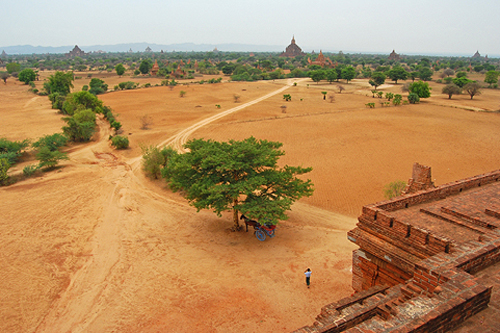
Uzana (r.1250-1254)
He liked sporting with elephants and to travel, finding many a pretty girl on his journeys. He was “wont to be merry even as heir-apparent in the reign of his father”.
One queen who was a poor village girl gave him a son. He traveled even as far as Dallah, a town across a river a small fisher village - that one day would become Yangon site of a holy pagoda that would be enlarged and gilded nearly two centuries later to become the great Shwedagon.
He 7 went to the realm of celestials' at the age of 38 after a wild elephant 'touched him', a polite usage for a royal body trampled to death.
Narathiha Pati (r. 1254-1287)
Uzana had a son by his chief queen but the ministers and plotted to place on the throne Narathiha Pati, son of the commoner village girl.
Once in power, he turned out to be more arrogant than believed to have been ignored in his former life, he was “violent in envy, proud and wrathful, and gluttonous in eating and drinking. ..Covetous and ambitious”.
His pride and willfulness drove him to refuse with some haughtiness the demands of Kublai Khan that Bagan must send tributes. Under the Sung dynasty, Bagan kings were treated with honor but the Khan had recently overthrown the Sung emperor and hoped to conquer all of Asia. The refusal to pay tributes brought the vengeful armies of Kublai Khan. The Bagan armies fought back valiantly but the king fled southwards down the Ayeyarwaddy River, forever earning him the name T'ayoke Pyay Min or the King who fled from the Chinese.
Thiha Thu, his son from a minor queen, offered sanctuary to his father on his flight and then forced him to eat poison. Filled witl1 bitterness for this betrayal, Narathiha Pati prayed with his dying breath that in all future lives he would never have a male child. He died at the age of 51.
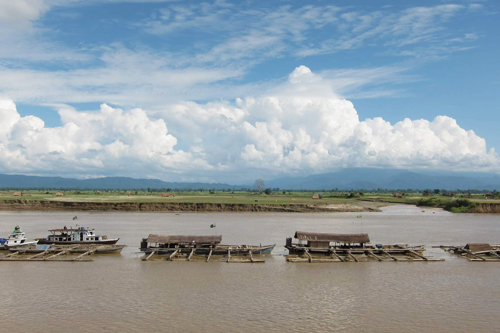
Kyaw Swar (r. 1287-1298)
Thiha Thu was soon killed by his half-brother Kyaw Swar who took the throne of the now-bereft Bagan, with the support of Kublai Khan, thought Kyaw Swar was not of kingly calibre and was killed and replaced with his young son Saw Hnit by three princes of Shan- Bamar descent, Athin Garaza, Raza Thingyan and Thiha Thu. They had once served at the Bagan court with their Shan father who was the governor of Myinsaing, a town to the north, their mother was Bamar.
At the death of KYaw Swar' Kublai khan again sent his forces but they were repelled at Myinsaing by Thiha Thu, youngest of the three Shan brothers. The Mongol armies retreated to China whereupon the Great Khan and immediately the Battle of Myinsaing is a great moment in Myanmar's history.
Saw Hnit (r.1298-1312)
Son of the previous king Kyaw Swar, he was only sixteen when was placed on the throne by the Shan brothers.
Saw Mon Hnit (r. 1312-1342)
When 'King' Saw Hnuit died, his son Saw Mon Hnit ascended the throne, an empty power as the glory of Bagan had passed with the death of Narathiha Pati.
After the fall of Bagan, the three brothers left to build three small kingdoms further north, near a place that was to become the city of Mandalay some 500 years later.
Thiha Thu's kingdom was named Pinya. It is said that he was presented with the carcass of a white elephant as even if dead, white elephants were considered highly auspicious. Since then, Thiha Thu took the title 'Hsin Byu Shin' or 'Lord of the White Elephant'. He also married a princess of the Bagan dynasty so that the blood of Bagan royalty ran in the veins of his heirs.
Many princes of the house of Bagan escaped with thousands of retainers to Toungoo, some 200 miles Southeast of Bagan. It was once situated deep in the inaccessible teak jungles, and thus safe from invasion. A powerful kingdom was to rise there two centuries later and kings of its dynasty would forge the Second Myanmar Empire.
By the time Saw Mon Hnit passed there was neither kingdom nor heir left in Bagan. The dynasty was gone but the bloodline continued for many centuries in other parts of the broken empire.

